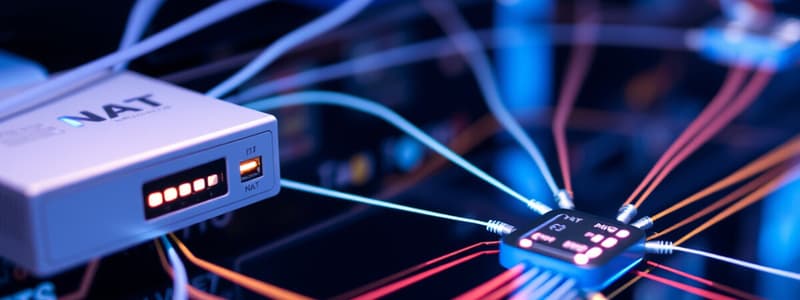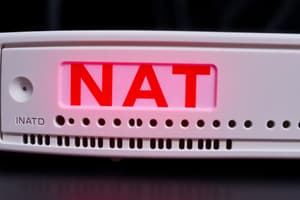Podcast
Questions and Answers
NAT conserves the legally registered addressing scheme by allowing the privatization of intranets.
NAT conserves the legally registered addressing scheme by allowing the privatization of intranets.
True (A)
One disadvantage of NAT is that it decreases forwarding delays.
One disadvantage of NAT is that it decreases forwarding delays.
False (B)
NAT provides consistency for internal network addressing schemes.
NAT provides consistency for internal network addressing schemes.
True (A)
NAT complicates the use of tunneling protocols such as IPsec.
NAT complicates the use of tunneling protocols such as IPsec.
NAT allows for easy change to a new private addressing scheme.
NAT allows for easy change to a new private addressing scheme.
End-to-end IPv4 traceability is preserved when using NAT.
End-to-end IPv4 traceability is preserved when using NAT.
Services requiring the initiation of TCP connections from the outside network can be disrupted by NAT.
Services requiring the initiation of TCP connections from the outside network can be disrupted by NAT.
NAT allows users' IPv4 addresses to remain visible to the public network.
NAT allows users' IPv4 addresses to remain visible to the public network.
Dynamic NAT requires a predefined pool of outside global addresses for translation.
Dynamic NAT requires a predefined pool of outside global addresses for translation.
In Static NAT, all devices share the same inside global address.
In Static NAT, all devices share the same inside global address.
If all addresses in the Dynamic NAT pool are in use, a device can still access the outside network.
If all addresses in the Dynamic NAT pool are in use, a device can still access the outside network.
Static NAT is used to map private IP addresses to public IP addresses permanently.
Static NAT is used to map private IP addresses to public IP addresses permanently.
NAT is primarily used to conserve public IPv4 addresses.
NAT is primarily used to conserve public IPv4 addresses.
The inside network in NAT terminology refers to all other networks.
The inside network in NAT terminology refers to all other networks.
Dynamic NAT is preferred over Static NAT for scenarios with variable traffic demands.
Dynamic NAT is preferred over Static NAT for scenarios with variable traffic demands.
Local addresses can be any address that appears on the outside portion of the network.
Local addresses can be any address that appears on the outside portion of the network.
The command 'ip nat pool' is used for defining the static NAT configurations.
The command 'ip nat pool' is used for defining the static NAT configurations.
Devices can access the outside network without any NAT configured.
Devices can access the outside network without any NAT configured.
Dynamic NAT can include Port Address Translation (PAT).
Dynamic NAT can include Port Address Translation (PAT).
Inside addresses are the addresses of devices that are not translated by NAT.
Inside addresses are the addresses of devices that are not translated by NAT.
Testing access without NAT is a necessary step in configuring static NAT.
Testing access without NAT is a necessary step in configuring static NAT.
Dynamic NAT mappings are permanent and do not change during the session.
Dynamic NAT mappings are permanent and do not change during the session.
In Dynamic NAT, each device can access any address in the pool on a first-come first-served basis.
In Dynamic NAT, each device can access any address in the pool on a first-come first-served basis.
NAT-POOL2 has allocated two addresses for both translations.
NAT-POOL2 has allocated two addresses for both translations.
The total active translations for NAT are four, with two being static.
The total active translations for NAT are four, with two being static.
The configuration for NAT indicates that there are 15 total addresses in the pool.
The configuration for NAT indicates that there are 15 total addresses in the pool.
Expired translations indicate that there are packets that have timed out.
Expired translations indicate that there are packets that have timed out.
The inside interface for the NAT setup is Serial0/1/1.
The inside interface for the NAT setup is Serial0/1/1.
The number of hits recorded is zero.
The number of hits recorded is zero.
Dynamic NAT with Overload can be configured in a Packet Tracer activity.
Dynamic NAT with Overload can be configured in a Packet Tracer activity.
CEFF translated packets indicate packets handled via Cisco Express Forwarding.
CEFF translated packets indicate packets handled via Cisco Express Forwarding.
The number of addresses allocated from NAT-POOL2 is 6.
The number of addresses allocated from NAT-POOL2 is 6.
In this implementation, the 'show ip nat statistics' command returns statistics for active translations.
In this implementation, the 'show ip nat statistics' command returns statistics for active translations.
PAT allows multiple hosts to share a single IPv4 address by using unique source port numbers.
PAT allows multiple hosts to share a single IPv4 address by using unique source port numbers.
The source IPv4 address modified by R2 for PC1 is 209.165.200.240.
The source IPv4 address modified by R2 for PC1 is 209.165.200.240.
PC1 and PC2 can transmit packets to Svr1 and Svr2 simultaneously without conflicts in their IP addresses.
PC1 and PC2 can transmit packets to Svr1 and Svr2 simultaneously without conflicts in their IP addresses.
In PAT, if two computers send packets to the same server, the source port number will remain the same for both transmissions.
In PAT, if two computers send packets to the same server, the source port number will remain the same for both transmissions.
The interface configuration for PAT requires defining inside and outside NAT interfaces.
The interface configuration for PAT requires defining inside and outside NAT interfaces.
The NAT pool defined in the configuration allows for IP addresses ranging from 209.165.200.226 to 209.165.200.240.
The NAT pool defined in the configuration allows for IP addresses ranging from 209.165.200.226 to 209.165.200.240.
Only one unique port number can be assigned to multiple hosts when using PAT.
Only one unique port number can be assigned to multiple hosts when using PAT.
The command 'ip nat inside source list 1 pool NAT-POOL2 overload' enables NAT for all devices in the local network.
The command 'ip nat inside source list 1 pool NAT-POOL2 overload' enables NAT for all devices in the local network.
R2 will only change the source IP address for packets that match access-list 1.
R2 will only change the source IP address for packets that match access-list 1.
The netmask in the NAT pool configuration is 255.255.255.0.
The netmask in the NAT pool configuration is 255.255.255.0.
Flashcards are hidden until you start studying
Study Notes
NAT Advantages
- NAT conserves legally registered IP addresses by allowing intranet privatization.
- Application port-level multiplexing aids in address conservation.
- Provides flexibility for connections to public networks.
- Maintains consistency in internal network addressing schemes.
- Permits unchanged private IPv4 addressing while facilitating transitions to new public addressing.
- Hides user and device IPv4 addresses for improved privacy.
NAT Disadvantages
- Increases forwarding delays, potentially affecting performance.
- Loses end-to-end addressing capabilities.
- Complicates traceability of end-to-end IPv4 communications.
- Complicates tunneling protocols like IPsec.
- Disrupts services requiring TCP connection initiation from external networks, particularly for stateless protocols using UDP.
Static NAT
- Static NAT allows fixed mapping of local addresses to global addresses.
- Useful for scenarios where consistent access to services is required without IP address changes.
Dynamic NAT
- Maps inside local addresses to inside global addresses dynamically.
- Utilizes a pool of inside global addresses, assigned on a first-come, first-served basis.
- If the pool is exhausted, new requests must wait for an available address.
Dynamic NAT Configuration
- Involves defining a pool of addresses using the
ip nat poolcommand. - Employs access control lists (ACLs) to permit specific inside local addresses for translation.
- Associates interfaces as 'inside' or 'outside' to define translation points.
PAT (Port Address Translation)
- Allows multiple inside local addresses to share a single inside global address by differentiating them via port numbers.
- Modifies the source IP address of packets to match a global address while incrementing port numbers to ensure uniqueness.
Verifying NAT Configurations
- The
show ip nat statisticscommand displays current NAT status including translation types, active translations, and address allocation. - Offers valuable insights into performance metrics like hits, misses, and the number of active translations.
Practical Applications
- Hands-on tasks in Packet Tracer related to testing access with and without NAT, configuring static and dynamic NAT, and verifying implementations provide practical experience.
- Configurations and verifications are essential to ensure proper functionality within IPv4 networks.
Fundamental Concepts
- Due to limited IPv4 addresses, NAT critically conserves public addresses by translating internal networks for external communication.
- The "inside" network encompasses devices subject to translation while the "outside" refers to all other networks.
- Local addresses include any addresses utilized within the internal segment of the network.
Studying That Suits You
Use AI to generate personalized quizzes and flashcards to suit your learning preferences.




